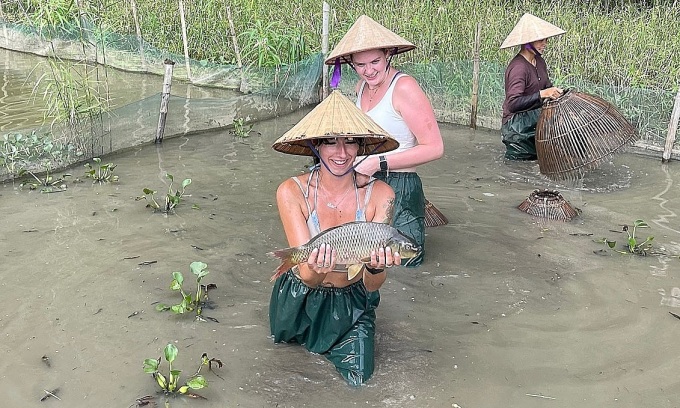Going the whole hog in Vietnam: foreign tourists enjoy herding buffaloes, catching fish
In November Romanian tourist Silviu visited Ha Giang Province in the north to explore the famous “Ha Giang loop,” but his guide unexpectedly took him to a place where locals were harvesting rice.
This unplanned activity became Silviu’s most memorable experience in Vietnam. For the first time in his life he got to cut, thresh, and separate rice grains by hand. Despite the language barrier, which made communication with the farmers impossible, he fondly recalls the fields being “filled with the laughter of foreign tourists.”
In Ninh Binh, also in the north, foreign tourists are able to enjoy similar experiences as more locations now offer activities such as herding buffaloes and catching fish.
Verus, a visitor from New Zealand, describes these activities with locals as “a truly wonderful time.” She spent more than half a day at a farm, where she rode and bathed a buffalo, fished using a traditional basket, and cooked a meal in a kitchen just like a local.
“It was incredibly relaxing, and I think international tourists should definitely try this when visiting Vietnam,” she says, adding she never imagined the life of a farmer could be so fascinating.
A foreign tourist holds a fish she caught in a pond in Ninh Binh in northern Vietnam. Photo courtesy of Buffalo Cave Tours |
Photos and videos of Western tourists engaging in farming activities in Vietnam have garnered widespread attention on social media over the past year.
According to Pham Anh Vu, deputy general director of travel firm Du Lich Viet, while these activities began around 2010, coinciding with the growth of Vietnam’s tourism industry after the SARS epidemic when travelers increasingly sought to participate in local activities and explore rural life, they have gained more attention recently due to the rise of social media.
“After the Covid-19 pandemic, international tourists are more drawn to nature-based experiences and deeper cultural explorations.”
Cao Kim Kien of Buffalo Cave Tours, the company that organized the tour for Verus, says more and more tourists are eager to experience travel that connects them with local life. In the past, the company had around 60 tourists a day who sought these experiences, but the number has now increased to 100, he says.
Visitors are increasingly seeking authentic, hands-on experiences rather than traditional “superficial” tourism, he adds.
Alex Sheal, the founder of Vietnam In Focus, a company that offers photography tours, says he always strives to immerse guests in local lifestyles whenever possible. Recently his clients have had the chance to make incense in Quang Phu Cau village in Hanoi’s Ung Hoa District and help farmers harvest rice in Mu Cang Chai District in Yen Bai Province northwest of the capital.
“They find it interesting and feel a connection with both locals and fellow travelers,” Sheal says.
Best Price regularly offers foreign tourists local experiences such as fishing and duck catching in the Mekong Delta and HCMC, vegetable farming in Hoi An and performing traditional dances, and staying in stilt houses in Mai Chau.
Bui Thanh Tu, its marketing director, says most guests enjoy these activities and participate “seriously.” The company focuses on offering deeper cultural experiences such as going to local markets to buy food for their meals and cycling through rice fields, and its programs in Hue and Hoi An have been well received by foreign tourists, with many saying they “feel the hospitality of the Vietnamese people,” he adds.
Sheal says foreign tourists enjoy these rural experiences because traditional farming practices, now replaced by machines in developed countries, pique their curiosity. Besides, backpackers, the main participants in these activities, are growing weary of traditional, heavily commercialized tourism.
Silviu agrees, noting that rice harvesting in Ha Giang is no longer seen in Western countries. In the West, agriculture has been mechanized, leading to the disappearance of traditional labor practices.
 |
Tourists vising Dong Ba market for food in Hue. Photo courtesy of Du Lich Viet |
But according to many in the tourism industry, more attention needs to be paid to improving the experience for visitors. They point out that, for instance, in Ha Giang visits to paddies often last only five to 10 minutes, barely enough time to take photos or videos. Silviu suggests that travel agencies should invest in programs like “a day with farmers.”
According to Vu, agriculture-based tourism is a promising business model that travel companies should pay attention to.
Besides enhancing the image of Vietnam’s tourism, it also brings economic benefits to local communities, thus contributing to the preservation of traditional cultures, he says.
“We need to invest in more specialized programs and improve service quality to meet the tastes of international tourists.”
Sheal warns that these experiences need to be authentic and not commercialized into mass-market products since tourists might shun them if they become “inauthentic and forced.”


Comments are closed.